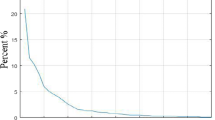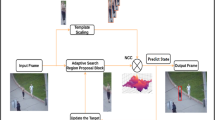Abstract
In this paper, a tracker based on mean shift and radial basis function neural networks called MS-RBF is addressed. As its name implies, two independent trackers have been combined and linked together. The mean shift algorithm estimates the target’s location within only two iterations. The scale and orientation of target are computed by exploiting 2-D correlation coefficient between reference and target candidate histograms instead of using Bhattacharyya coefficient. A code optimization strategy, named multiply–add–accumulate (MAC), is proposed to remove useless memory occupation and programmatic operations. MAC implementation has reduced computational load and made overall tracking process faster. The second tracker “RBFNN” has an input feature vector that contains variables such as local contrast, color histogram, gradient, intensity, and spatial frequency. The neural network learns the color and texture features from the target and background. Then, this information is used to detect and track the object in other frames. The neural network employs Epanechnikov activation functions. The features extracted in any frame are clustered by Fuzzy C-Means clustering which produces the means and variances of the clusters. The experimental results show that the proposed tracker can resist to different types of occlusions, sudden movement, and shape deformations.




















Similar content being viewed by others
References
Arora, A., Dutta, P., Bapat, S., Kulathumani, V., Zhang, H., Naik, V., et al.: A line in the sand: a wireless sensor network for target detection, classification, and tracking. Comput. Netw. 46, 605–634 (2004)
Velastin, S., Yin, J., Davies, A., Vicencio-Silva, M., Allsop, R., Penn, A.:Automated measurement of crowd density and motion using image processing. In: Proceeding of Seventh International Conference On Road Traffic Monitoring And Control, 26–28 April 1994 (IEE Conference Publication 391) (1994)
Azuma, R.T.: A survey of augmented reality. Presence 6, 355–385 (1997)
Ubillos, R.: Method and apparatus for video editing with video clip representations displayed along a time line. ed: Google Patents (1999)
Mountney, P., Stoyanov, D., Yang, G.-Z.: Three-dimensional tissue deformation recovery and tracking. Sig. Process. Mag. IEEE 27, 14–24 (2010)
Khan, Z.H., Gu, I., Backhouse, A.G.: Robust visual object tracking using multi-mode anisotropic mean shift and particle filters. IEEE Trans.Circ. Syst. Video Technol. 21, 74–87 (2011)
Babu, R.V., Parate, P.: Robust tracking with interest points: a sparse representation approach. Image Vis. Comput. 33, 44–56 (2015)
Zhang, K., Zhang, L., Yang, M.-H.,: Real-time compressive tracking, in Computer Vision–ECCV, 2012, ed: Springer, pp. 864–877 (2012)
Lucas, B.D., Kanade, T.: An iterative image registration technique with an application to stereo vision, in IJCAI, pp. 674–679 (1981)
Black, M.J., Anandan, P.: The robust estimation of multiple motions: parametric and piecewise-smooth flow fields. Comput. Vis. Image Underst. 63, 75–104 (1996)
Horn, B.K., Schunck, B.G.: Determining optical flow. In: Technical Symposium East, pp. 319–331 (1981)
Yilmaz, A., Li, X., Shah, M.: Contour-based object tracking with occlusion handling in video acquired using mobile cameras. IEEE Trans. Pattern Anal. Mach. Intel. 26, 1531–1536 (2004)
Zhao, P., Zhu, H., Li, H., Shibata, T.: A directional-edge-based real-time object tracking system employing multiple candidate-location generation. IEEE Trans. Circ. Syst. Video Technol. 23, 503–517 (2013)
Botella, G., Martín, H.J.A., Santos, M., Meyer-Baese, U.: FPGA-based multimodal embedded sensor system integrating low-and mid-level vision. Sensors 11, 8164–8179 (2011)
Comaniciu, D., Meer, P.: Mean shift: a robust approach toward feature space analysis. IEEE Trans. Pattern Anal. Mach. Intel. 24, 603–619 (2002)
Comaniciu, D., Ramesh, V., Meer, P.: Kernel-based object tracking. IEEE Trans. Pattern Anal. Math. Intel. 25, 564–577 (2003)
Kailath, T.: The divergence and Bhattacharyya distance measures in signal selection. IEEE Trans. Pattern Anal. Mach. Intel. 15, 52–60 (1967)
Bradski, G. R.: Computer vision face tracking for use in a perceptual user interface (1998)
Zivkovic, Z., Krose, B.: An EM-like algorithm for color-histogram-based object tracking. In: Computer Vision and Pattern Recognition, 2004. CVPR 2004. Proceedings of the 2004 IEEE Computer Society Conference on, vol. 1, pp. I-798-I-803 (2004).
Carreira-Perpindn, M.: Gaussian mean-shift is an EM algorithm. IEEE Trans. Pattern Anal. Mach. Intel. 29, 767–776 (2007)
Shan, C., Wei, Y., Tan, T., Ojardias, F.: Real time hand tracking by combining particle filtering and mean shift. In: Automatic Face and Gesture Recognition, 2004. Proceedings. Sixth IEEE International Conference on, pp. 669–674 (2004)
Shan, C., Tan, T., Wei, Y.: Real-time hand tracking using a mean shift embedded particle filter. Pattern Recog. 40, 1958–1970 (2007)
Chen, Z.: Bayesian filtering: from Kalman filters to particle filters, and beyond. Statistics 182, 1–69 (2003)
Rowghanian, V., Asl, K.A.: Non iterated mean shift and particle filtering. In: Iranian Conference on Electrical Engineering (ICEE), 22nd, pp. 226–231 (2014)
Chen, Z., Husz, Z.L., Wallace, I., Wallace, A.M.: Video object tracking based on a Chamfer distance transform. In: Image Processing, 2007. ICIP 2007. IEEE International Conference on, 2007, pp. III-357-III-360
Babu, R.V., Suresh, S., Makur, A.: Online adaptive radial basis function networks for robust object tracking. Comput. Vis. Image Underst. 114, 297–310 (2010)
Black, M.J., Jepson, A.D.: Eigentracking: robust matching and tracking of articulated objects using a view-based representation. Int. J. Comput. Vis. 26, 63–84 (1998)
Huang, G.-B., Siew, C.-K.: Extreme learning machine: RBF network case. In: Control, Automation, Robotics and Vision Conference. ICARCV 8th, pp. 1029–1036 (2004)
Bin, Z., Junzheng, W., Jiali, M.: Algorithm of target tracking based on mean shift with RBF neural network. In: Chinese Control Conference ,CCC 27th, pp. 518–521 (2008)
Meyer-Bäse, A., Botella, G., Rybarska-Rusinek, L.: Stochastic stability analysis of competitive neural networks with different time-scales. Neurocomputing 118, 115–118 (2013)
Shi, C., Brodersen, R.W.: Floating-point to fixed-point conversion with decision errors due to quantization. In: Acoustics, Speech, and Signal Processing, 2004. Proceedings.(ICASSP’04). IEEE International Conference on, 2004 vol. 5, pp. V-41-4 (2004)
Botella, G., Meyer-Baese, U., García, A., Rodríguez, M.: Quantization analysis and enhancement of a VLSI gradient-based motion estimation architecture. Digit. Signal Proc. 22, 1174–1187 (2012)
Bârleanu, A., Băitoiu, V., Stan, A.: Floating-point to fixed-point code conversion with variable trade-off between computational complexity and accuracy loss. In: System Theory, Control, and Computing (ICSTCC), 2011 15th International Conference on, pp. 1–6 (2011)
Oshiro, M., Nishimura, T.: US image improvement using fuzzy Neural Network with Epanechnikov kernel. In: Industrial Electronics, 2009. IECON’09. 35th Annual Conference of IEEE, pp. 2130–2135 (2009)
Jack, K.: Video demystified: a handbook for the digital engineer. Newnes, Boston (2005)
Ning, J., Zhang, L., Zhang, D., Wu, C.: Scale and orientation adaptive mean shift tracking. IET Comput. Vis. 6, 52–61 (2012)
Ning, J., Zhang, L., Zhang, D., Wu, C.: Robust mean-shift tracking with corrected background–weighted histogram. IET Comput. Vis. 6, 62–69 (2012)
Asvadi, A., Karami, M., Baleghi, Y.: Efficient object tracking using optimized K-means segmentation and radial basis function neural networks. Int. J. Inf. Commun. Technol. 4(1), 29–39 (2011)
Author information
Authors and Affiliations
Corresponding author
Appendix
Appendix
The following code is in MATLAB programing language. Note that the number of data must be high to see a stable ratio of times.
n = 50,000; x = rand(n,6); mu = rand(1,6);tic; for i = 1:n, t = sqrt(sum((x(i,:) − mu(:)’).^2)); end; t1 = toc;
tic;for i = 1:n, t = (x(i,1) − mu(1))^2 + (x(i, 2) − mu(2))^2 + (x(i,3) − mu(3))^2 + (x(i,4) − mu(4))^2 + (x(i,5) − mu(5))^2 + (x(i,6) − mu(6))^2; t = sqrt(t);end;t2 = toc;
Rights and permissions
About this article
Cite this article
Rowghanian, V., Ansari-Asl, K. Object tracking by mean shift and radial basis function neural networks. J Real-Time Image Proc 15, 799–816 (2018). https://doi.org/10.1007/s11554-015-0524-4
Received:
Accepted:
Published:
Issue Date:
DOI: https://doi.org/10.1007/s11554-015-0524-4




